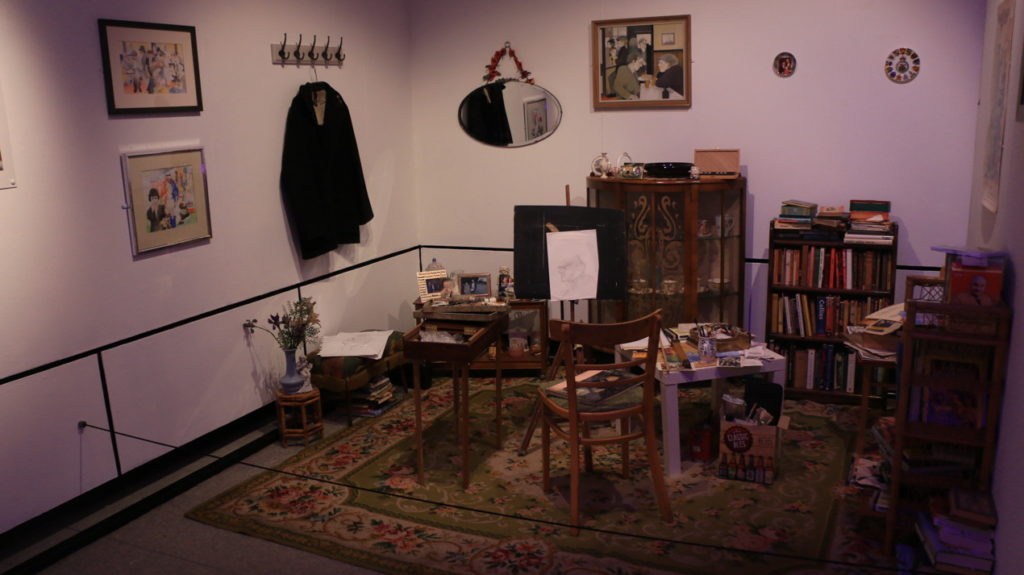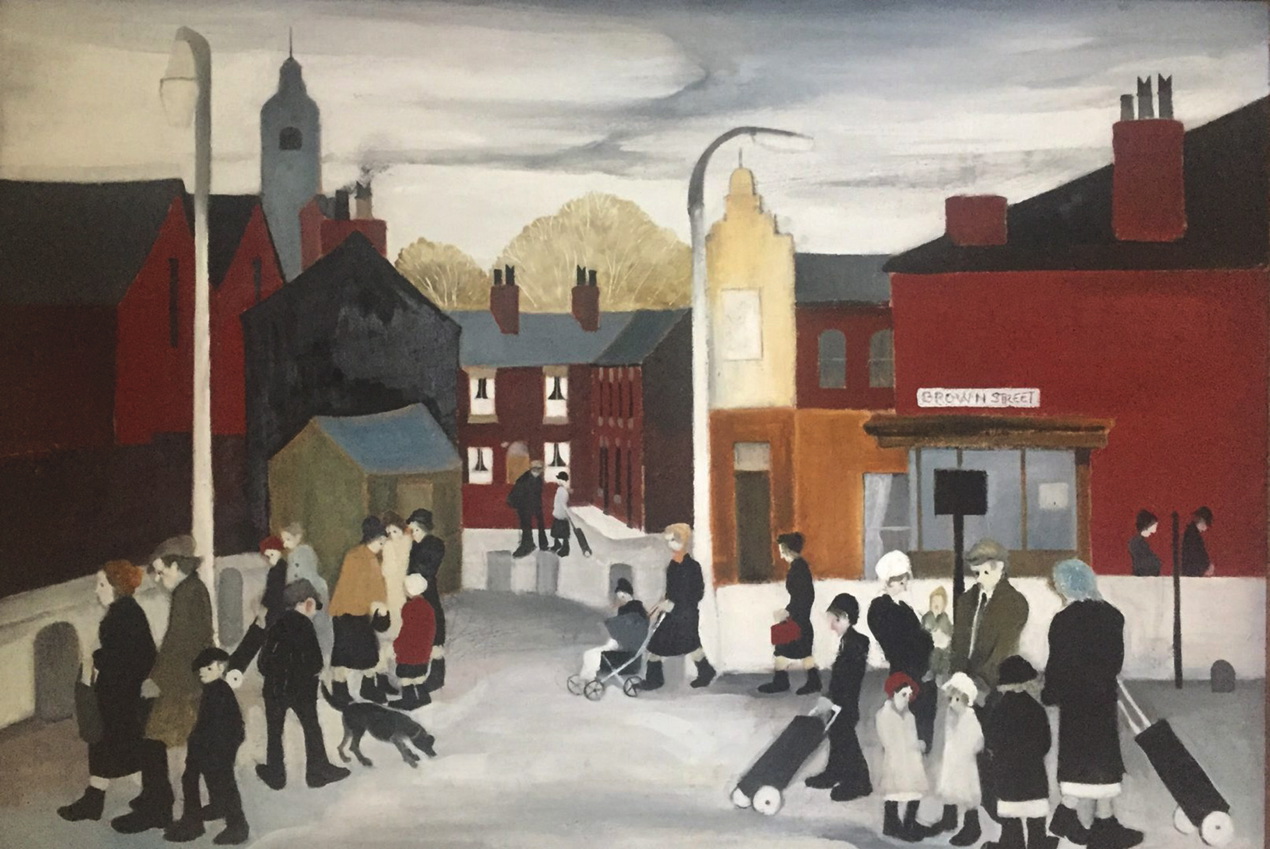Eric Tucker: The Unseen Artist
When former boxer and labourer Eric Tucker died in 2018 his family discovered 400 paintings and countless drawings and he became an unlikely art sensation dubbed the Secret Lowry
Tell us about your uncle as you knew him.
I was very close to my uncle. As a child he picked me up from school every day, in a car with a smashed door window held together with sellotape. We shared a love of art and comedy. He was very funny and he was kind to me, a brilliant storyteller who could command the room, but he could also be very shy and diffident. He was a man who loved people and yet he was also something of a loner. He was eccentric, he had his own set ways – he didn’t have a bank account and he avoided using the telephone. He was an inveterate gambler, mainly horse racing, placing small bets in complex accumulators. He was an old school socialist and he felt a great affinity with people who were oppressed or on the margins. He
had no time for social barriers. If he found himself in anything like formal company he’d say: “We’ll break ‘em down.” As an adult when I moved to Manchester and then London, he’d always encourage me to seek out the roughest pubs and bars. “That’s where the real life is,” he’d tell me.
What did you know of him as an artist?
All my life I knew that he painted. The door was generally shut but I’d sometimes go into the front parlour and see what was on his easel. His painting wasn’t something he kept a secret exactly, but he certainly didn’t advertise it – it was just something he quietly worked at, seemingly for himself. He’d sometimes give me a bit of guidance on drawing as a kid, and a couple of times I painted with him – painting clowns, sort of making my own knockoffs of his work! I remember he’d say to me “Stop! It’s finished” but I’d want to continue tinkering.
Was it a revelation to discover the extent of his work after he died?
We really had no idea just how much work he’d produced until he died. I thought there might be 50 or 60 paintings in his house but, as my dad – Eric’s younger brother – was clearing the place out, each day he’d call me to tell me they’d opened another wardrobe, or the garden shed, and found another 30-odd paintings. In the end my dad found more than 400 paintings and countless drawings, and it was very emotional for me because I realised this was the main work of my uncle’s life. It wasn’t just a hobby – he was an artist. I saw so many paintings that I’d never seen before and then I was really struck by just how good they were – how sophisticated his technique was, his use of colour, how he captured his world so intimately and with such emotional depth.

Why do you think Eric didn’t put his work out for the world to see?
It’s difficult to know why he didn’t promote himself as an artist, I can only really speculate. A few times over the decades family members, especially my dad, encouraged him and helped him to try to show his work – but he was generally resistant, and these few tentative attempts were largely met with rejection. I think it was probably a mix of character and life circumstances, and of course the latter affects the former. There are huge obstacles, both tangible and psychological, facing working-class artists, and I think this is probably as true today as it was in my uncle’s life. For a working-class guy born in Warrington in the 1930s, the dream of becoming an artist probably seemed as remote as becoming, say, a cabinet minister. I think the art world probably felt extremely middle class and inaccessible to him. And there’s a pride there too, I think. Why would you want to try to get into a party that doesn’t generally admit people like you? He seemed to lack confidence and after a few attempts, he gave up trying to find recognition. But he never gave up painting. If anything his productivity increased. And there’s actually a strange kind of confidence in that, I think – declaring, in effect, that you do not need validation to produce your work. You do it regardless.
How did his work come to be exhibited at Warrington Art Gallery?
In the final months of his life Eric told my dad that he’d like his work to be seen and he mentioned perhaps a few of his paintings being shown in his home town gallery. My dad made some initial contact with the gallery but it didn’t come to much. Then I had the idea of opening his house, over a weekend, as a gallery – inspired by the artist Jeremy Deller, who put on an exhibition in his parents’ house. It seemed to me like this was a great venue in which to see the work – the place where it was all created –and, given my uncle’s penchant for hoarding, the house itself was something of an exhibit. In my head, the exhibition was a bit of an excuse to have a private view, in order to invite curators and people from the art world. I didn’t think many people would come to the actual exhibition, maybe a few curious locals. A couple of curators from Warrington Art Gallery came and one young curator from Manchester Art Gallery, to whom I remain forever grateful, but other than that, no-one else RSVPd, so I thought the project had slightly failed. Then on the Saturday morning, as I went to put the sign outside the house, I realised a queue had formed around the block. Following this Warrington Museum & Art Gallery offered us an Eric Tucker retrospective and we jumped at the chance.
Do you feel more pride than regret that Eric didn’t live to see this?
I do feel some regret that he didn’t live to see this but, if I’m honest, I’m not exactly sure we could’ve done this while he was alive. I can all too easily imagine him suddenly having second thoughts about the exhibition and pulling the plug days beforehand for inscrutable reasons. More than that though I regret that I didn’t see all his work and fully appreciate it during his lifetime, and so I didn’t get to tell him in person just how good an artist I’ve come to realise he was. But mostly I feel great pride, pride in what he achieved in his work, and the fact that he’s now finally finding an audience.
People point things out to me in the paintings that I hadn’t noticed – influences or details of the subject matter – which is a strange experience but also very gratifying. The place he was coming from, his perspective, is rare and his work has a sophistication which I think belies his outsider status. It’s worthy of serious consideration and I hope it will be seen as far and wide as it can be and that he achieves now what he couldn’t in life – to be a recognised artist.
